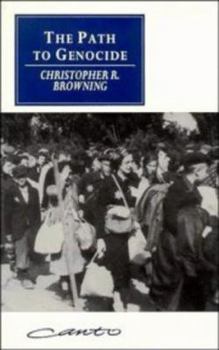The Path to Genocide: Essays on Launching the Final Solution
Select Format
Select Condition 
Book Overview
The Path to Genocide studies three aspects of the events leading up to the Final Solution in Nazi Germany. First, Nazi's solutions to their self-imposed Jewish problem before resorting to mass-murder... This description may be from another edition of this product.
Format:Paperback
Language:English
ISBN:0521558786
ISBN13:9780521558785
Release Date:September 2010
Publisher:Cambridge University Press
Length:208 Pages
Weight:0.10 lbs.
Dimensions:0.6" x 5.3" x 8.4"
Customer Reviews
2 ratings
Superb Summation Of Natural History Of The Holocaust!
Published by Thriftbooks.com User , 21 years ago
In an eight-essay series originally devised as lectures, the author takes the reader deep into the hearts and minds of the men who engineered and perpetrated the Holocaust. As in his earlier work, he argues persuasively and with an army of facts and figures that the decision to eradicate all of Europe's Jews from the face of the planet was an incrementally derived decision. This argument is very much like that made by Gerhard Weinberg in his massively documented history of WWII, "A World At Arms", although Browning's argument involves a much more detailed and substantiated thread of evidence and circumstance. Weinberg posited that it wasn't until the Wehrmacht began to have horrendous logistics problems early in the occupation of Poland, Latvia, and Estonia during Operation Barbarossa that they began to think in terms of a systematic and deliberate program of extermination of the Jews. Until that point the Nazi command had been more favorably disposed toward using indigenous populations as slave labor and working and/or starving them to death, rather than killing them outright. Here too Browning argues about three key issues surrounding the decision to proceed with the Holocaust; first, that the Nazi hierarchy itself was divided in terms of strategy and objectives about the resolution of the "Jewish Question"; second, that it was seen as highly advantageous to the national socialist cause to employ their skills and labor as long as possible in support of the war effort, and finally, that the actual implementation of the fragmented policy was further fragmented and "ad-libbed" at the field level by local commanders or police authorities. Browning uses a virtual flood of documentation and data to substantiate his various positions, and marshals a convincing argument on behalf of the notion that indeed the resulting mass murders of the Holocaust were more likely the production of a series of small but fateful conclusions made incrementally to solve immediate and pressing logistical and tactical situations the Nazi hierarchy faced at particular moments than it was the result of some long-standing grand and evil scheme to systematically annihilate the Jews. Of course, it is in one very real sense an academic issue, since all of the indigenous Jews (as well as everyone else in the areas of interest to the Nazis along the eastern front in Poland and the Ukraine already pre-designated as new settlement areas for Germans would die at the hands of the Nazi regime. The question at hand is whether the actual extermination of those individuals would be accomplished through slave labor, starvation, and exposure to the elements, or through more active and murderous intervention by way of the death camps. One must also remember that there were also large numbers of German Jews being transported both within and without the country to concentration camps. The same issues of intent apply to them, as well. Certainly Browning's efforts here will not end the long-st
Decision to Kill: How it was Taken.
Published by Thriftbooks.com User , 23 years ago
Browning's book is one of the best books I have ever read about the Holocaust. It is a must for any researcher on this theme, new one or advanced. The most important topic of the book, dealt in several chapters, is the question of when, how, why and by whom the final solution command or order was taken. Browning is very specific in his research. There are no guessings, though we can not escape from not being able to give final answer to certain details. He works with data of documents in trying to track how the decision to kill was taken. He is able to get to the point of saying the most probable dates for the final decision by Hitler.The book presents some answers and alternatives to the question. It analyses 'functionalism' and 'intentionalism' and theories of historians like Arno Mayer, which by the way sufers heavy critics by Browning. You will surely refer back to this book after reading it when discussing the subject of the decision making process of the Holocaust.




